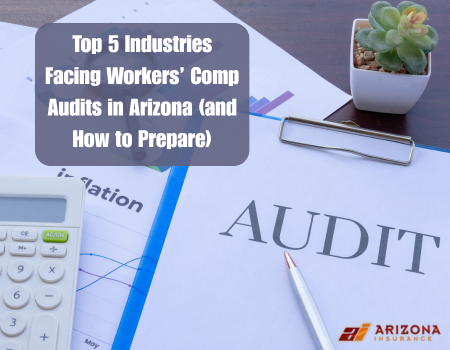 For Arizona business owners, being vigilant about workers’ compensation compliance isn’t optional, it’s essential. A timely audit by your insurer or the Industrial Commission of Arizona (ICA) can uncover mis-classifications, payroll discrepancies, employee versus contractor issues or insufficient safety programs. The fallout? A significant audit bill, higher premiums, or even legal exposure. Understanding which industries are more likely to be audited, and how to prepare, can save you time, money and stress.
For Arizona business owners, being vigilant about workers’ compensation compliance isn’t optional, it’s essential. A timely audit by your insurer or the Industrial Commission of Arizona (ICA) can uncover mis-classifications, payroll discrepancies, employee versus contractor issues or insufficient safety programs. The fallout? A significant audit bill, higher premiums, or even legal exposure. Understanding which industries are more likely to be audited, and how to prepare, can save you time, money and stress.
Why audits happen and why they matter
A workers’ comp audit verifies that your policy’s estimated payroll, classification codes and employee counts match actual data during the policy period. Mis-classifying workers, under-reporting payroll or failing to document independent contractors can trigger adjustments or penalties. For Arizona, every employer with one or more employees must carry workers’ compensation insurance unless exempt. Proper preparation forms a key component of your business risk management strategy and avoids surprise large audit bills.
Top 5 industries in Arizona most at risk of audits
These five sectors tend to attract the most attention for workers’ comp compliance due to higher claim frequencies, large payroll shifts, seasonal staffing or high-risk work environments.
- Construction & Contractors
Construction is inherently high risk, with heavy equipment, heights, and multiple subcontractors. It’s also one of the most audited sectors for mis-classification and payroll documentation. For example, a Phoenix-area contractor had a large audit bill when an executive supervisor was coded in a high-risk classification. - Transportation, Warehousing & Logistics
Workers driving vehicles, loading/unloading goods, or operating large equipment face elevated injury risk. National data show this industry among those with frequent compensation claims. - Manufacturing & Fabrication
With heavy machinery, repetitive motion hazards and large employee counts, manufacturing firms often face scrutiny. Payroll changes, temporary workers and multiple job classifications make audit readiness key. - Healthcare & Assisted Living
Nurse and caregiver roles involve lifting, patient transfers and high injury potential. The complexity of staffing models (employees, temps, per-diems) increases audit risk. - Landscaping, Tree Care & Specialty Trade Services
These businesses often employ seasonal or subcontracted labor, making classifications and payroll verification more complex. Industry materials cite such trades among “high-risk businesses” for workers’ comp.
Audit-readiness: Insurance compliance checklist
Here’s a practical checklist to help your business prepare for a workers’ comp audit in Arizona:
- Payroll records: Maintain detailed records of gross payroll, overtime, seasonal hires and subcontractor payments.
- Employee classifications: Ensure each worker is classified properly based on actual duties. Mis-classification can trigger higher premiums.
- Independent contractor documentation: Ensure written contracts and proof the contractor carries their own workers’ comp if they’re truly independent. Contractors with no coverage can fall back on your policy.
- Coverage certificates: Maintain current certificates of insurance for subcontractors and vendors. Auditors will review these.
- Safety & risk-management program: Document injury prevention programs, training logs, safety meetings and incident reports. A strong safety record improves audit outcomes.
- Timely reporting of claims and injuries: In Arizona, employers must report work-related injuries within required timeframes. Delays may attract attention.
- Policy review before renewal: Don’t wait until renewal to review payroll. Revision of estimates mid-year can reduce surprises during the audit.
Strategic steps for business risk management
- Engage your insurance broker early: A knowledgeable broker can help you review classification codes, payroll estimates and contractor exposures.
- Reconcile payroll vs. policy expectations: If your business has grown, changed job types or increased subcontractor use, update your carrier ahead of audit.
- Create an audit folder: Prepare a binder or digital file with payroll summaries, job classifications, contractor COIs and safety records.
- Train your team: Make sure your HR or payroll staff understand workers’ comp issues—especially classification and contractor distinctions.
- Conduct periodic self-audits: Every 6–12 months, review your payroll, employee roles and subcontractor status so you can correct issues proactively.
If your business operates in one of the high-risk industries listed above, you should assume you’ll face an audit and plan accordingly. Effective audit readiness and solid insurance compliance practices go hand in hand with broader business risk management efforts. By staying organized, up-to-date, and proactive, you minimise the risk of unexpected audit bills and ensure your workers’ compensation coverage works in your favour, and not against you.
